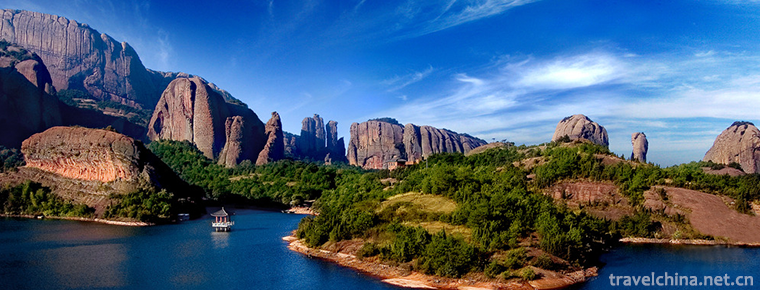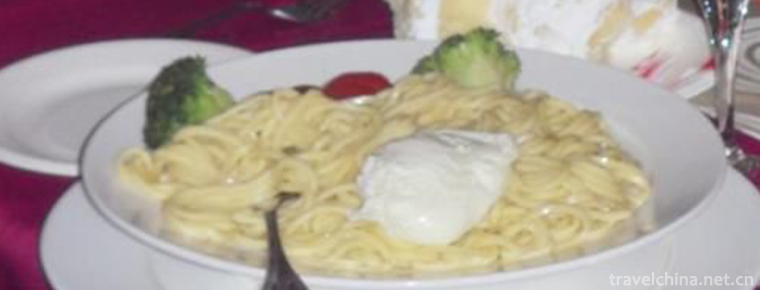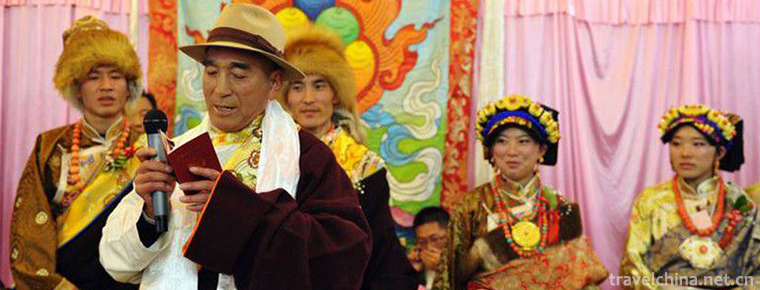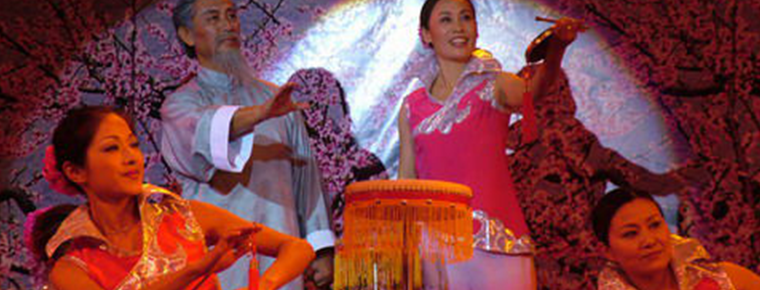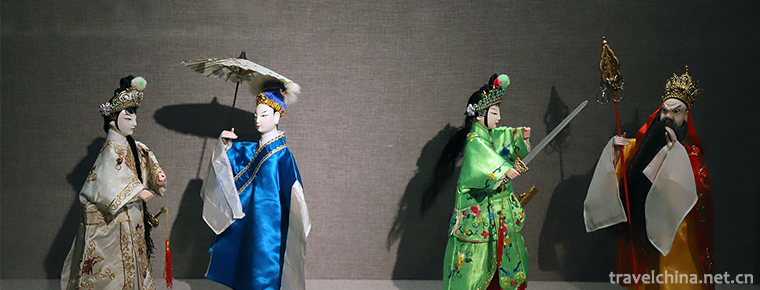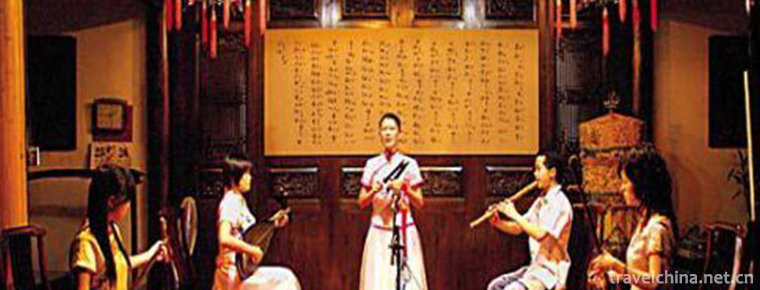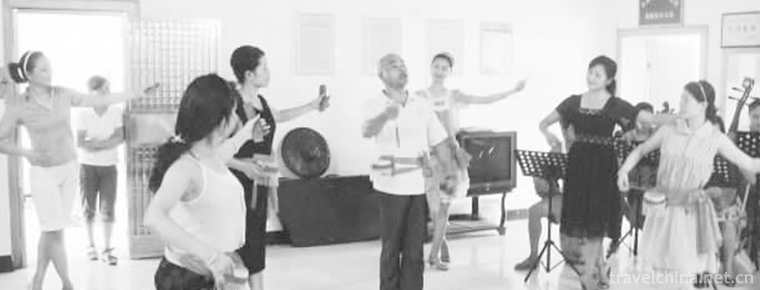Jindian Scenic Spot
Jindian Scenic Spot
Kunming Golden Palace Scenic Spot, also known as Tongwa Temple, is made of brass and shines in the sunshine, reflecting the golden brilliance of Cuigou Youlin. The prestigious Golden Palace is part of the Taoist Taihe Palace. It was built in the Ming Dynasty (1602), and is one of the four bronze palaces in China. It is the best preserved one. In the ten years of Kangxi (1671 A.D.), King Wu Sangui of Pingxi was renovated with a long history. The golden palace has beautiful natural scenery, the path goes through the forest, the green trees cover the sky and the sun, and occasional bird song, which is the essence of Taoist culture. In the early spring, the 100 mu tea flowers in the "Golden Palace Expo Garden" in the scenic spot are opening up, reflecting the sky is red and beautiful.
In January 2019, ticket prices for the scenic spot were lowered.
Development history
In the 16th year of Guangxu in the Qing Dynasty (1890), Shuzao's "Rebuilding the Tablet of Taihe Palace" recorded the history of Taihe Palace's creation in detail: "Outside Dongguan of Julan (Kunming) Huiyuan in southern Yunnan, about 15 miles away from the city, there are hills and phoenixes, also known as Parrot Hill. Before the Ming Dynasty, Xu Zhengyuan, a Taoist priest, invited Chen Gongbin, governor of Yunnan Province, to join him with Mu Gongchangzuo, governor of Guizhou State, and Mu Gongrui, governor of the right capital. The imperial envoy, Liu Gonghui, built the Forbidden City on the top of the 72 peaks of Wudang Mountain in Huguang, and smelt bronze as a palace to build the golden body of Zhenwu ancestor. The name of the palace is Taihe, which is also modeled after the name of the Zhongfeng Palace in Wudang Mountain. At that time, Sanyuan Palace and Huancui Palace were built. The sacred immortal Buddha offered by them had their own specialties. Visitors can trace their history. And its palace is generally ruled by the Taihe Palace. On the left is the beauty of Huashan Mountain, Jinma Tenghui, and on the right is the shore of Kunhai Sea, where the green chicken is shining and Shun is a scenic spot in southern Yunnan. Villagers call it the Golden Temple or the Golden Roof, letting their message come out."
Based on historical data, this inscription describes the time when Kunming Taihe Golden Palace was founded in imitation of Wudang Mountain in Hubei Province, the founder, the Taoist scale of bronze smelting, the worship of Zhenwu Golden Body, and the mountain situation of Mingfeng Mountain. In 1602, Xu Zhengyuan, a Taoist priest in the Ming Dynasty, invited Chen Youbin, governor of Yunnan, to join Mu Changzuo, governor of Guizhou, Mu Rui of the right capital, and Liu Hui, the imperial envoy, to climb to the top of Ming Fengshan Mountain, and agreed to build the Taihe Palace in imitation of the peak of Wudang Mountain. This is consistent with the Ming Dynasty Wanli Jiachen (1604), the founder of Taihe Palace in the first month of the Ming Dynasty. Shuzao's inscriptions are described in vernacular and easy to read. Chen Youbin's inscriptions in classical Chinese are not easy to read.
The inscription on Shuzao's tablet said that it was inaccurate to build Sanyuan and Huancui Second Palace at that time. In fact, seven years before the founding of Taihe Palace, the "Huancui Palace" had been built. Chen Yongbin wrote The Records of the Huancui Palace, which said: "In the three years of Yu Fu's reign in Yunnan, the official was appointed to build the Huancui Palace in Mingfeng Mountain. There were two palaces, one for the pavilion and the other for the sacrifice of Lu Shi (Lu Dongbin). Wang, Tao Tianjun, He and Liu Erxian were sacrificed to the pavilion." Chen Youbin, a native of Jinjiang, Fujian Province, and a scholar of Ming Dynasty, was the governor of Yunnan Province in the twenty-first year of Wanli (1593). Chen Youbin "Fuyun three years", that is, twenty-three years of Wanli (1595), he "ordered the official to build the Huancui Palace in Mingfeng Mountain". In the 30th year of Wanli (1602), Xu Zhengyuan, the Taoist monk who built the Golden Palace of Taihe Palace by Chen Youbin, was the Taoist monk of Huancui Palace.
As stated in Chen Yongbin's Dian Jian Taihe Palace Records, "Nine Years of Fuyun", that is, 30 years of Wanli (1602), Chen Yongbin "Cheng Bu Sheng Dongcheng, a few improper people in Xiangdu Mountain, looking around, Zhenqi Ying, even around the left of Cuigong Palace, turning a blind eye to the lotus pheasant, the jade bureau is just like that, and there is no room for Guangyue to be despaired?" Chen Yongbin and Mu Changzuo, Murui and Liu Hui went to Dushan to choose the site of Busheng. They have already seen that the mountain situation "coiled around the left of the Cuigong Palace". This clearly shows that when Chen Yongbin chose the location of Taihe Palace in the 30 years of Wanli in Ming Dynasty, there was Huancui Palace. The Golden Palace and Sanyuan Palace of Taihe Palace were built in 1602, the 30th year of Wanli in Ming Dynasty. "When the project is completed, it will be renovated in the first year of Wang Zhengzhi's moon." "Wanli Jiachen (1604) is the first lunar month of spring and auspicious day," written by Chen Youbin, "The Records of Dingjian Taihe Palace".
According to folklore, Chen Yongbin once met Lu Dongbin three times in Mingfeng Mountain. It was Lu Xian who quoted him that Mingfeng Mountain was a "blessed place in the cave". So he "fu Yunnan three years" that is, "the official was appointed to build a green palace around Mingfeng Mountain", "among them, he worshiped Lu Shi for the pavilion". After the completion of the Huancui Palace, Chen Youbin wrote couplets:
Spring dream used to charming, a piece of Dynasty clothes, missed nine immortal bones, chicken singing purple Mo, Horse Stepping on the red dust, the military gate jumped out to that end?
The empty mountain once had an appointment with him. In the words of seven Fujian, we invited six imperial cups of tea. The shadow of the sword was flying across the sky. The flute sounded like the sea. Where did Mr. Wu come from?
Chen Youbin, who lives in Yunnan Province as a "military gate governor", is fascinated by the "one-piece court clothes" in official circles and yearns for the Taoist "Nine Laos Immortal Bones". His ambivalent mood is that only Lu Xianren who flies from "Sword Shadows across the sky, flute sounds blowing the sea", should he "jump out to that end"?
Chen Yongbin's "Jiantaihe Palace Records" begins with a phrase: "Emperor Xuandi Tianyi's essence, riding Xuanwu as the throne, the most famous trace is Taihe, Zhengguan but also, can worship on behalf of others. I am the ancestor of Emperor Mu Youfang, style outline its system, let Longyan for thousands of years..." It is said that Zhenwu Xuandi is the "essence of Tianyi, taking Xuanwu as emperor". Zhenwu miracle, Taihe Mountain (that is, Wudang Mountain) is the most famous. Since the reign of Zhenguan in Tang Dynasty, sacrifices have been worshipped from generation to generation. Zhu Di, the ancestor of the Ming Dynasty, believed in Zhenwu and ordered that Mount Wudang be renovated for thousands of years. Wudang Mountain has a legend of "true God of martial arts, Yongle image". In the future, the world's real palace of martial arts will sculpt true martial arts according to this "Yongle image".
In 1637, the Golden Palace of Chongzhen in Ming Dynasty moved to Jizu Mountain in Binchuan. The records in the historical records are consistent. In 1637, Zhang Fengyi, governor of Yunnan Province, moved the Tongdian Temple to Tianzhu Peak of Jizu Mountain in Binchuan. Tianzhu Peak is also called "Golden Peak". Jizushan Bronze Hall was destroyed in 1966 during the "Cultural Revolution" and "Sweeping the Four Old Ages". When Zhang Fengyi moved the copper palace, the base of the copper palace of Taihe Palace and the sand and stone relief railings of the lower platforms were not dismantled and preserved to this day.
During the reign of Kangxi in the Qing Dynasty, the copper palace of Taihe Palace in Mingfeng Mountain was rebuilt, and "Fan Tong amounted to more than 5 million tons" (250 tons). In 1980, when cleaning the smoke and dirt in Tongdian Hall, it was found that the inscription on the main girder of Tongdian Hall was covered with dirt, and the words in the middle of the girder were covered by algae wells. I climbed up to see that it was "the ten-year-old Prince Wu Sangui Jingzhu of Jiping West of 1911 on the 10th and 6th day of Luyue of the 10th anniversary of Kangxi Emperor The inscription confirms that Wu Sangui renovated the Taihe Palace in 1670, rebuilt the Zhenwu Bronze Palace, cast bronze statues, erected "more than ten Zhangs of bronze rafters, pavilions and special pavilions" in the ninth year of Kangxi in Qing Dynasty. The Kangxi Decade (1671) was completed on October 16. Because Wu Sangui Kangxi raised troops in the twelfth year (1673) to fight against the Qing Dynasty, the inscription of local chronicles was only called "Nine Years of Kangxi in the Qing Dynasty" and avoided being Wu Sangui's copper palace.
After Wu Sangui rebuilt the bronze Hall of Zhenwu, he cast a "seven-star sword" and hung it in the hall. This is Zhenwu's "wisdom sword hanging high, often volcanic and strange" inscribed in the inscription. Wu Sangui left a wooden handle knife weighing 12 kilograms (6 kilograms) in Taihe Palace to show off its military power.
On the front of the bronze hall, the bronze plaque of the Southern Infinite Life Buddha was hanging in 1694 by Wang Jiwen, Governor of Yunnan and Guizhou in the 33rd year of Kangxi reign of the Qing Dynasty. Many people wonder why a Buddhist plaque was placed in the Palace of Zhenwudao, a famous Confucian governor of Yungui. Wudang Mountain records that when Zhenwu Bronze Hall was built on the top of Wutian pillar peak in Yongle 14 (1416), there were Buddhist infinite longevity Buddhist temples on the top of Wutian pillar, and Buddhism and Taoism were not mutually compatible. Knowing that building the bronze hall is the Holy will, Buddhists compromise, "let the earth not let Buddha", Zhenwu Hall hangs the "infinite longevity Buddha" plaque, worship Zhenwu, but also praise "the infinite longevity Buddha in the south". Taihe Palace of Mingfeng Mountain was built in imitation of the mid-peak of Wudang Mountain. Wang Jiwen hangs a plaque according to the allusions of Wudang Mountain.
In the twenty-five years of Qing Daoguang's reinvention of Ertianmen Tablet in 1845, two earthquakes occurred in Kunming in the Qing Dynasty were recorded: "During the reign of Qianlong, the earthquake in Yunnan Province, the rescue of the Star Banner, and the spiritual symbols were evident". The earthquake had little impact. Daoguang "13 years (1833) July 23, Yunnan earthquake, restored the temple archway, guest tea house, shaking and destroyed." The greater calamity of the Taihe Palace was the destruction of the Taihe Palace in the years of Xianfeng and the ashes of the Sanyuan Palace. After each damage, repairs were made to varying degrees. Among them, during the 15 years from 1890 to 1905, Taihe Palace abbot Li Mingqing urged to recruit "Wang Chi of Jin Gen", Yu An turned to supervise Yunnan Minerals and Tang Gongjing, former governor, and advocated casting 10,000 kilograms of copper, with donations from all his colleagues. Foundry pavilions, attendant statues, lattice fan tiles, and rebuild mountain gates, archways, temples, all new.
The Golden Palace of Taihe Palace was taken over militarily in 1950 and designated as "Kunming Golden Palace Scenic Area". They are successively under the administration of the Bureau of Culture and Education, the Bureau of Construction, the Bureau of Culture and the Bureau of Landscape Architecture. During the "Cultural Revolution" in 1966 and "sweeping away the Four Old Ages", clay statues in various palaces were destroyed, palaces collapsed and barren tobacco and vines were grown. In 1968, Taihe Palace was designated as a dormitory of Kunming Locomotive Tyre Factory, which was recovered by Kunming Urban Construction Bureau in 1970.
After the smashing of the Gang of Four, the ancient buildings were repaired year by year, the Thunder Temple, Laojun Hall and Sanfeng Hall were rebuilt, three Tianmen Gates and Fengxing Gates were renovated, corridors and pavilions were built, and the walls of the Ming Dynasty were partly repaired. In 1983, the Peak Bell Tower was built to protect the Yongle Bell of the Ming Dynasty, the former Xuanhua Tower of Kunming City.
From 1983 to 1991, 273 mu of land was newly expropriated in the East and south of Mingfeng Mountain, and a 500 mu-scale "Kunming Garden Botanical Garden" was built. Garden botanical garden is divided into 12 special flower garden tea garden, greenhouse flower area, azalea garden, waterscape garden, Magnolia garden, rose garden, Bamboo Botanical garden, naked seed plant area, rare and endangered botanical area, garden demonstration area, parrot garden (bonsai area) and cedar lawn garden. The provincial and municipal governments have invested more than 8 million yuan.
In order to welcome the World Horticultural Exposition held in Kunming in 1999, from 1997 to 1999, the municipal government invested 20 million yuan in the Golden Palace of Mingfeng Mountain, comprehensively repairing the ancient buildings of Taihe Palace, renovating the bell tower, opening up the tourist service area of the bell tower, constructing large-scale ornamental greenhouses, building a new azalea boutique garden, developing orchard and fern botanical gardens, rebuilding autumn garden restaurants, rebuilding tourist hostels and rebuilding gardens. Travel toilet inside. On the basis of self-financing of Jindian to build "China Golden Palace Expo Garden", the bronze cultural tourist attractions of Jindian will be further developed. This renovation and construction is the largest renovation and construction of the Golden Palace of Taihe in 400 years. Jindian Scenic Area was ranked as the first-class scenic spot in Yunnan Province in 1999. It is the tallest building on Mingfeng Mountain. It climbs the building and looks around. It has a wide view. It is an ideal place in the eastern suburbs.
geographical environment
Kunming Jindian Scenic Area is located at the foot of Mingfeng Mountain in the eastern suburb of Kunming City, 8 kilometers away from the urban area. Built in the Ming Dynasty, Chen Youbin imitated the Taihe Palace and the Golden Palace of Tianzhu Peak, Wudang Mountain, in Junxian County, Hubei Province, with slight changes. So far, it has been more than 380 years. Wu Sangui has been rebuilt for more than 210 years. Golden Hall is more intact than the Golden Hall of Longevity Mountain in Beijing Summer Palace, and larger than the Golden Hall of Wudang Mountain in Hubei Province. The Golden Hall is the largest existing pure copper cast hall in China.
Kunming Golden Palace, that is, Zhenwu Palace, its pillars, doors, merchants and roofs are all cast in copper. It is 6.7 meters high, 6.2 meters wide and 6.2 meters deep, with a net weight of 14 tons. The Heavy Eaves Palace is a magnificent, brilliant and dazzling palace, hence the name of the Golden Palace. Its architecture embodies the superb technology of copper smelting in Yunnan 300 years ago. There are seven copper flags hanging beside the hall, which makes the golden hall more simple and solemn. In the exhibition room, bronze bells cast in the 21st year of Yongle Ming Dynasty (1423 A.D.) and battle knives used by Wu Sangui are displayed. The Golden Palace and its inscriptions have important historical, artistic and scientific values, and are now the key cultural relics protection units in China.
Walking from the hillside cottage, crossing Yingxian Bridge and entering Mingfeng Scenic Spot, the way is "First Day Gate", "Two Days Gate" and "Three Days Gate". Climbing up the Tianmen Gate, you can see the ancient and solemn "Taihe Palace" gate. Lianyun: "Painted buildings cover only three mu of green hills; Zhulou reflects the sun, so don't open a green field for a heavy sky." enter
Monastery gate, and then across the Fengxing Gate, you can see the towering brick city, about dozens of feet long, slightly like the imperial Forbidden City. Along the steps to the "city", facing the high steps, is the central building of the Taihe Palace, the famous Golden Palace.
There is a "Ming Bell Tower" in the southeast of the Golden Palace. The building is three floors with 36 corners and glazed top, about 30 meters high. On the third floor of the Golden Palace hangs a large copper bell, 2.1 meters high, 6.7 meters in circumference, 15 centimeters thick and 14 tons in weight. The words "Daming Yongle 21-year-old made in Jizhong Chunji Japan" are cast on the bell. It was cast in 1432 A.D. and has a history of 560 years. This Zhongyuan hangs over the Xuanhua Tower (southwest of the recent building) in Kunming. When the Xuanhua Tower is demolished, it is moved to the ancient park. In order to protect this cultural relic, the government moved the clock to the Golden Palace and allocated funds for the construction of the clock tower in 1983. It is the tallest building on Mingfeng Mountain. It climbs the building and looks around. It has a wide view. It is an ideal place for the eastern suburbs to overlook.
There is a big plaque on the gate of Taihe Palace in Jindian Park. The plaque says four words: "Parrot Spring Deep", which means that spring is abundant here all year round. The gate of the temple is called "Weixing Gate". On both sides of the gate are couplets praising the scenery and Taoism. The Golden Palace is not only one of the four bronze halls in China, but also the heaviest and best preserved one.
In addition to the Golden Palace, there are walls, gates and battlements, with upstairs. In the rear of the palace, there are also one Camellia and two Lagerstroemia plants, which are traditionally planted in the Ming Dynasty. Taihe Palace also has a 20-kilogram seven-star sword, a magic weapon of Zhenshan for Zhenwu Voldemort to make strange things, and a 12-kilogram wooden handle knife, which is said to have been used by Wu Sangui.
The natural scenery in Jindian Scenic Area is beautiful. Path through the forest, green trees shade the sun, sunlight from the gap between the leaves, appear on the ground mottled visible. The journey is quiet and occasional bird song is the essence of Taoist culture. The purple air coming eastward, vague, and the scenic area "Golden Palace Expo Garden" in the 100 mu camellia, reflecting the sky is red, beautiful.
natural resources
Camellia in Jindian is famous both at home and abroad. There are thousands of potted Camellia in Jindian Tea Garden. Camellia, also known as Camellia, is one of the eight famous flowers in Yunnan Province. Its cultivation history has been more than 500 years. Yunnan is known as the hometown of camellia. Camellia is also the city flower of Kunming. At the end of winter and the beginning of spring, hundreds of flowers are still sleeping, leaves are falling, only Camellia blossoms are blooming brilliantly. Tens of thousands of trees swallow fire together and the snow burns red for half a day. The brilliant Camellia in the golden palace warms up tourists with the general feelings of fire.
Tourism information
transit
It can take bus No. 10, No. 71, No. 69, No. 146, No. 47, or cable car from the Expo Garden or ropeway from the Expo Garden.
Bus
It can be reached in half an hour by taxi, or by cable car from the Expo Garden or by ropeway from the Expo Garden.
Travel Tips
The Golden Palace Scenic Spot enjoys camellias, photographs and strolls .




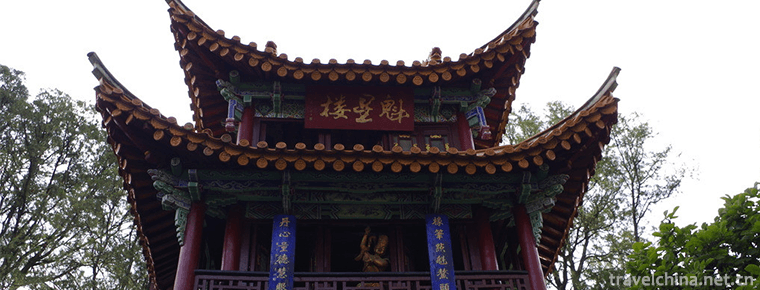
-
Turtle peak Scenic Area
Guifeng Scenic Spot is located in the southwest of Yiyang County, Jiangxi Province, beside 320 National Highway, 311 Highway and Zhejiang-Jiangxi Railway. It is 10 kilometers away from Yiyang County a.
Views: 150 Time 2019-01-13 -
Baxian longevity noodles
Make it with Udonghua noodles. With turtle, old turtle boiled soup, turtle has a nourishing role, old turtle represents longevity. Take shrimp, squid, sea cucumber, black fish balls.
Views: 173 Time 2019-03-27 -
Eighteen Sayings on Tibetan Wedding Banquet
The Eighteenth Tibetan Wedding Banquet is a kind of folk oral literature spread in the Tibetan inhabited areas of the eastern agricultural region of Qinghai Province. Its manifestation is the eighteen.
Views: 108 Time 2019-04-07 -
Firing Techniques of Liling Unglazed Colorful Porcelain
The firing technology of Liling Unglazed Five-color Porcelain, the local traditional firing technology of Liling Unglazed Five-color Porcelain in Hunan Province, is one of the national intangible cult.
Views: 165 Time 2019-05-13 -
Gongs and drums
The Gong and drum books used to be called "Taibaoshu", "Taibao" is derived from the activities of "Taibu" in the countryside of Shanghai suburbs and counties, which seeks.
Views: 119 Time 2019-05-15 -
Puppet Show
Chinese puppet show has a long history. The common view is that it originated in the Han Dynasty and flourished in the Tang Dynasty. In the Three Kingdoms, couples could perform acrobatics, while in t.
Views: 109 Time 2019-06-06 -
opera sung in southern tunes
Southern Opera is the earliest mature type of drama in the history of Chinese opera. From the end of Northern Song Dynasty to the beginning of Ming Dynasty (12th to 14th centuries), Southern Opera was.
Views: 105 Time 2019-06-07 -
Yangju Opera
Yangju, a local traditional drama in Yangzhou City, Jiangsu Province, is one of the national intangible cultural heritage. Yangzhou Opera, formerly known as "Weiyang Opera", is popular in Ya.
Views: 255 Time 2019-07-10 -
Yongxin Drum
Yongxin Xiaogu is one of the traditional operas in Ji'an City, Jiangxi Province, which originated from Taoism. Legend has it that it was formed in Yongxin, Jiangxi Province during the reign of Qingdao.
Views: 177 Time 2019-07-14 -
Jianshan natural scenic spot
Jianshan scenic spot, located in the west gate of Zigong, Yandu city and rongbian town of Ziliujing District, is a provincial-level natural scenic area in Sichuan Province. .
Views: 349 Time 2020-10-15 -
Nanchong ecological environment
In 2019, the total amount of funds used for environmental protection capacity building and supervision and operation of Nanchong City is 14.1809 million yuan, including 2.4476 million yuan for monitoring capacity construction and 11.7333 million yuan for environmental.
Views: 311 Time 2020-12-17

